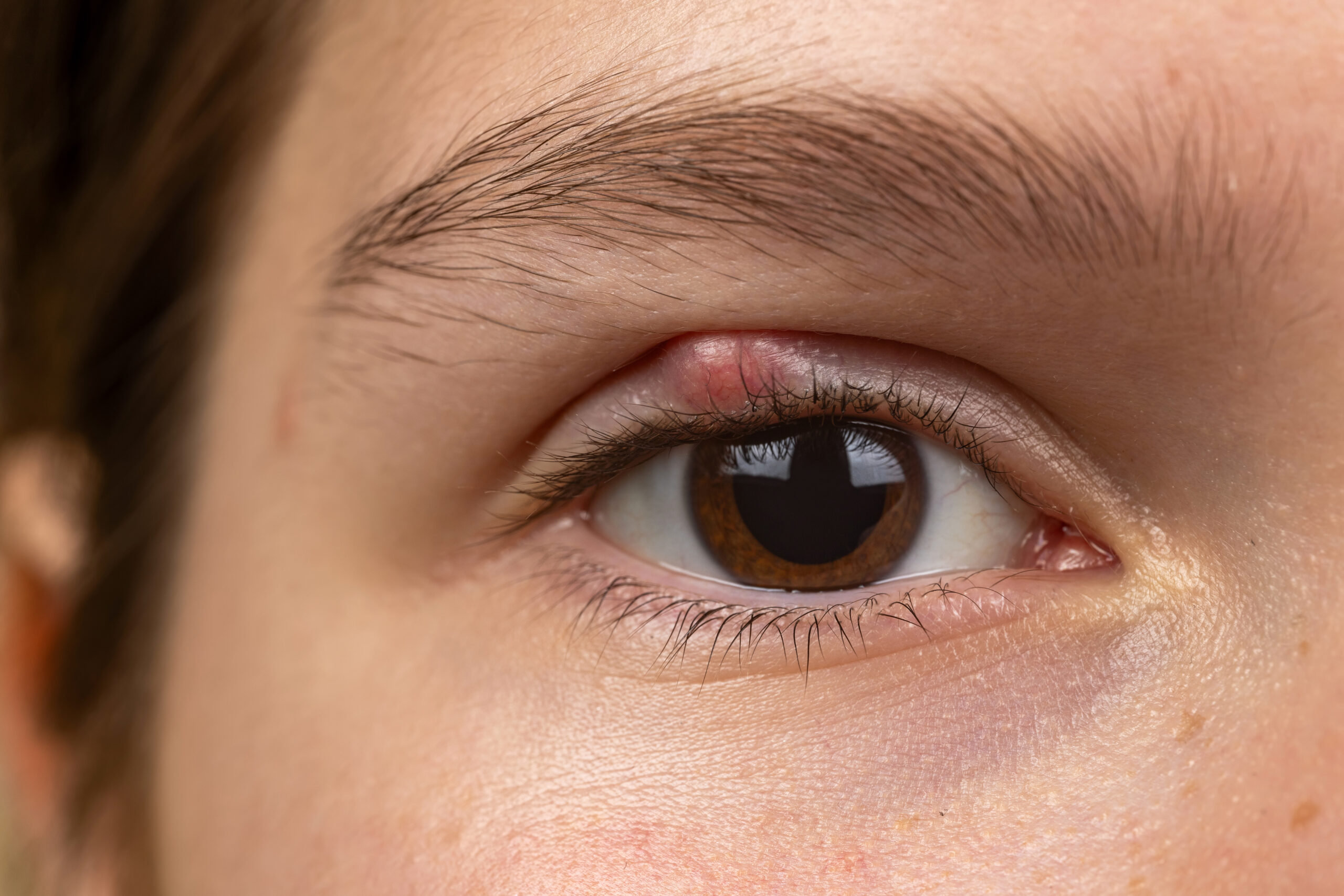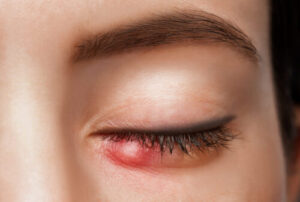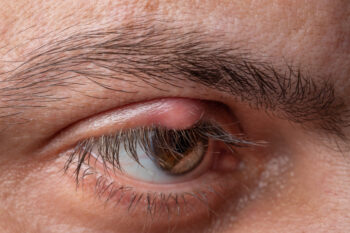
Chalazia (plural of chalazion) are among the most common inflammatory lesions of the eyelid.
A chalazion consists in a small swelling or lump on the eyelid, caused by a blocked gland1.
Although it may be very unsightly and sometimes impressive, it is not a serious condition and does not threaten your eye or your vision.
Chalazia occur mostly in adults, especially women under 40 years old, but may also affect children1,2.
Without treatment, chalazia frequently become chronic3, meaning that they remain visible or go away and come back.
Some people are particularly prone to chalazia4, which tend to occur on a regular basis. Such a susceptibility may be related to underlying conditions that promote lid glands congestion.
Chalazion happens when an eyelid’s oil gland clogs up1.
These glands, called « Meibomian glands », named after the doctor Heinrich Meibom who first described them in 1666, are embedded into the eyelids: twenty to thirty glands are located in the lower lid, and thirty to forty are located in the upper lid5.
They produce an oily secretion called « meibum », more or less similar to the sebum from sebaceous glands in the skin. Meibum mixes with the tears and spreads onto the ocular surface, to ensure its lubrication6. This mix is called the “tear film” and is necessary to protect the ocular surface from drying and forms a barrier against particles such as pollens, bacteria and viruses5.
The gland obstruction is caused by the thickening of its walls, leading to a narrowing of the gland duct and orifice, and by an increase in the meibum viscosity5,6: normal meibum is an oily liquid, but when the Meibomian glands are dysfunctional, the meibum thickens and can take on the consistency of toothpaste. Congealed meibum is not able to drain from the gland, hence the blockade and the swelling.
Several factors are suspected to contribute to meibomian glands dysfunction, such as aging, contact lens wearing, menopause, rosacea, seborrheic dermatitis, atopic dermatitis, antidepressant, some hormonal therapies, eyelids inflammation (blepharitis), diabetes, high blood cholesterol …1,5,6
Many people with such meibum condition also have symptoms of dry eye disease, which is rather expected, as the lack of meibum in the tears is associated with an increased concentration and evaporation of the tears6

Meibomian glands are the tiny elongated glands embedded into the upper and lower eyelids. The orifice of each gland opens out at the edge of the eyelids, allowing their oily secretion, the meibum, to flow onto the surface of the eye, where it mixes with the tears.
A chalazion usually starts out small, barely noticeable at first, looking like a little red and swollen spot on your eyelid, with little or no pain.
In a matter of days or weeks or even months, the lump grows to about the size of a pea or sometimes of an olive, usually no larger than 1 cm. As it grows, the chalazion may become inflamed, and the eyelid gets red, swollen, usually painless but sometimes tender to touch.
If the chalazion gets large, it can press on your eye and cause blurry vision. Sometimes, the whole eyelid might swell.
Chalazia are most likely to happen on the upper eyelid, either on the outer side of the lid, where it forms a spherical lump, or on the inner side of the lid: seen from the outside, the eyelid is merely red and swollen, and the chalazion shows up only when turning the eyelid inside out.
Chalazion is not primarily due to an infection. However, a chalazion can become infected and acutely inflamed, causing a tense, warm lid swelling7.
The diagnosis can be made based on the appearance of the chalazion, which is usually quite typical, and no further tests are required to confirm the diagnosis.
Nevertheless, it may sometimes be difficult to tell the difference between a stye and a chalazion1. Unlike the chalazion, stye is caused by an infection of the eyelash root and is very painful, with a spot of pus and centered on an eyelash1.
In case of a persistent chronic eyelid nodule, it is recommended to consult a doctor. The ophthalmologist may sometimes decide to take a biopsy to be sure that the lump is merely a chalazion and not a more serious eye problem1.
Most chalazia will clear up and heal in a matter of weeks.
First of all, chalazion treatment involves emptying the clogged gland. This may be performed by applying warm compresses or a heating mask on the lid during approximatively 15 minutes, 2 to 4 times a day, to soften the meibum, followed by a gentle lid massage to drain the meibum and decongest the inflamed gland4.
After the massage, it may be useful to clean the eyelid with specially adapted eyelid wipes. In one-quarter to one-half of cases, warm compresses and massage will be sufficient to cure the chalazion within one to 3 months of onset8.

IPL (Intense Pulsed Light) has been successfully used to treat chalazia, with a risk of recurrence divided by 3 compared to standard treatment8.
In general, don’t hesitate to ask your pharmacist for advice if you have any eye symptoms.
On the other hand, if you experience one or more of these symptoms, you should see an eye specialist as a matter of urgency; -Moderate,-Severe pain, -Intense sensitivity to light, -Decreased vision, -Flashes of light, -Dark spots, -Sensation of a foreign object in the eye, -Trauma (injury, contusion, acid burn etc.), -Persisting or worsening symptoms despite appropriate treatment.
